
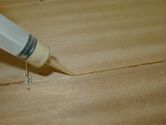
|
After
the hull is permanently epoxy stitched (picture above) and the deck is all
wired and plate edges nicely aligned, the deck plate stitching with epoxy
can begin. I chose a syringe method here because the application requires
more accuracy to inject the slurry into the narrow seams. Again, this initial
stitching fuses the deck together. When the stitches harden, the wires can
be removed. Any missing sections and grooves below the surface level as
well as the filling of the wire holes is done in the second filleting session.
Here is a close-up of the injection. The epoxy putty should be on the thinner
side perhaps like pancake batter so that it penetrates deep into the cracks.
Do not worry that the gaps are not filled completely. The point is to fuse
the plates first. When the epoxy sets, you will do a second round of filling
with thicker epoxy paste which will not run out of the cracks. The level
of the epoxy bead at this point should be above the plywood. |
 |
|
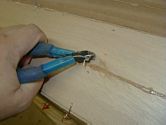 |
|
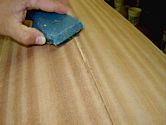 |
|
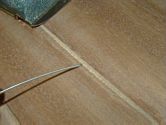 |
Careful
with shaving the deck plate fillets particualrly if you are using thinner
veneer plywood |
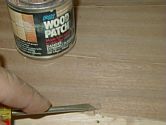 |
|
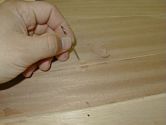 |
|
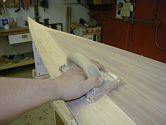 |
The
light sanding of the fillets to blend the radius to the adjacent plates
is just about the extent of the wood sanding. |
 |
The
main structural fillets on the inside hull. This procedure is timed after
both the deck and hull are fiberglassed on the outside. The joints are first
brushed with unthickened epoxy to penetrate into the pores and wood grain.
After a few minutes, wipe off the epoxy completely and apply thick bead
of stiff epoxy putty (non sagging). Now you can form nicely round and feathered
fillets across the sharp corners. I use a piece of a bent squeegee and adjust
the radius as the fillet requires. The fillets should transition really
smoothly (feather) into the surrounding plywood. I recommend to clean up
the fillet edges as best as you can because the fillets need to harden first
and the more messy you leave it the more sanding you will be doing before
fiberglassing the inside. Sanding hardened epoxy is far more time consuming
than spending the time being 'neat' in the first place.
See filleting in the Strip section
of the Kayak Shop. |
 |
Epoxy
putty - mixture of epoxy, colloidal silica (Cabosil), wood dust, chopped
microfibers and phenolic microbaloons.
There is no receipt for coloration of the putty or filler except trial and
error. |
 |
Putty
dispensing method three. An old silicone tube (clean). Wrap some packing
tape around the tip to reduce the size of the extruded bead. |
 |
The
caulking tube method is great for clean, fast and high volume slurry injection
such as on the outside hull seams or even for the inside fillets. |
 |
Close-up.
I am trying to build up the fillet bead past the plywood surface so that
I need not go back to fill the low spots later. The fillet is then easily
sanded and the outside hull can be glassed (unless you want to add decorative
stem bands). If so, I recommend to do these at this time. |
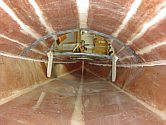 |
The
complete kayak innards immediately before bonding of the shells at the sheerline.
The picture is to show the internal deck fillets which are made using the
same principles as for the inside hull. You are looking into the kayak from
the front hatch towards the stern.
Note the 'footbrace location' markers on the inside hull on the extreme
right and left of the picture.
Let's continue where we left off - on the deck plates. |











